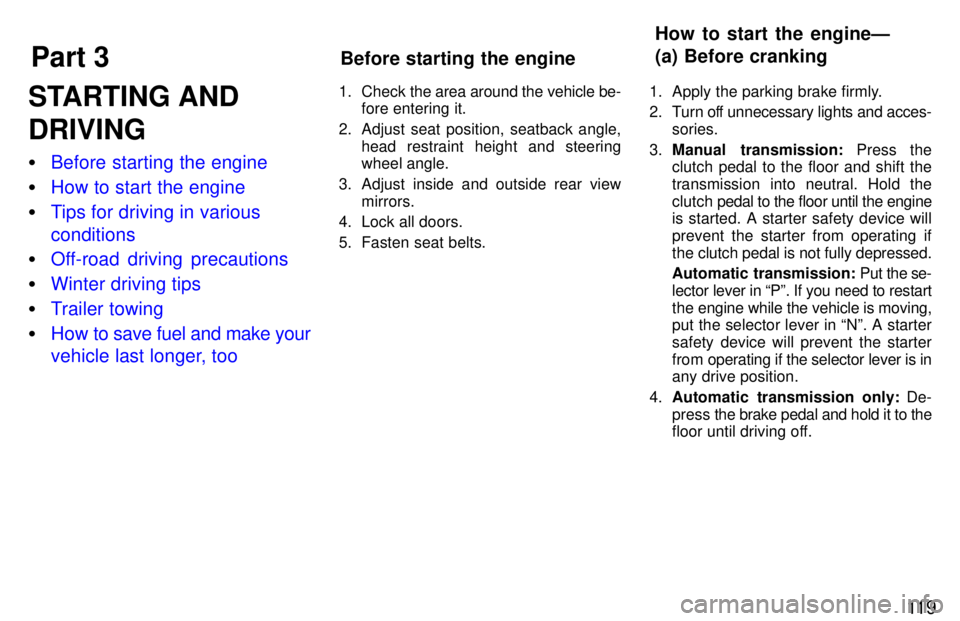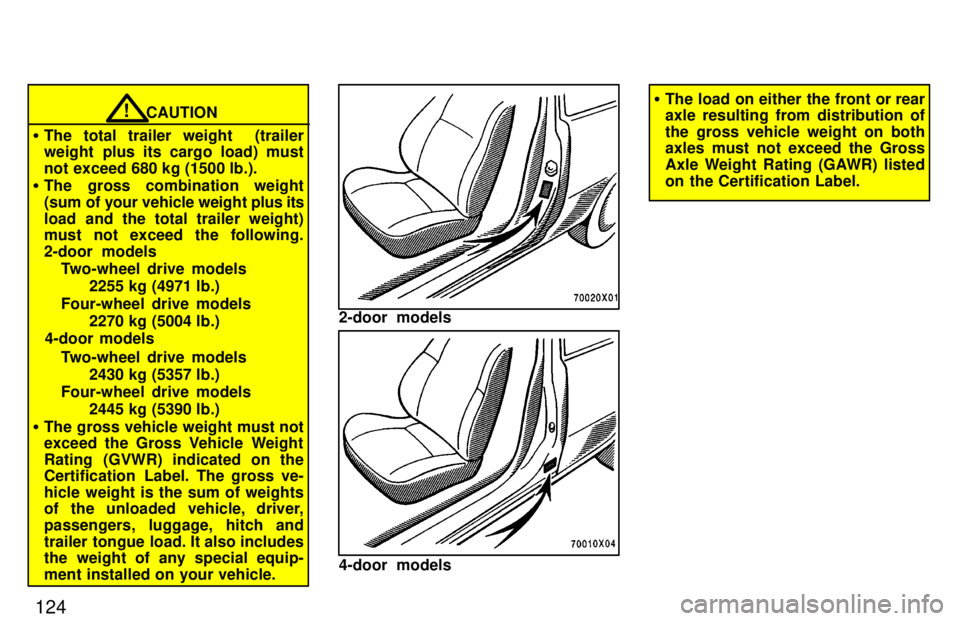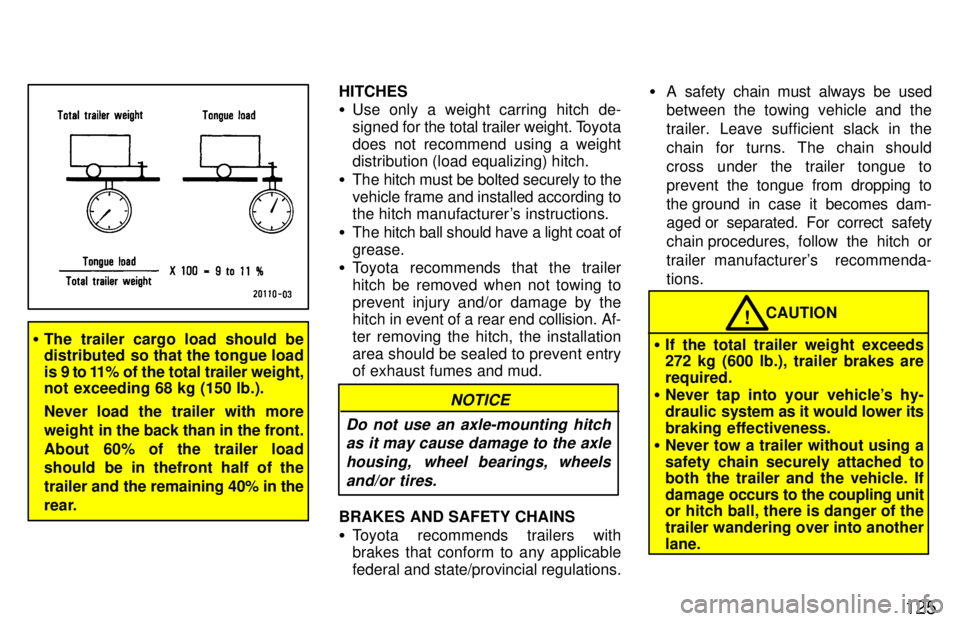1997 TOYOTA RAV4 trailer
[x] Cancel search: trailerPage 72 of 198

70
The gauge indicates the engine cool-
ant temperature when the ignition
switch is on. The engine operating
temperature will vary with changes in weather and engine load.
If the needle moves into the red zone, your engine is too hot. If your vehicle
overheats, stop your vehicle and allow the
engine to cool.
Your vehicle may overheat during severe operating conditions, such as: � Driving up a long hill on a hot day.
� Reducing speed or stopping after high
speed driving. �
Idling for a long period with the air con-
ditioning on in stop-and-go traffic.
� Towing a trailer
NOTICE
�Do not remove the thermostat in
the engine cooling system as this
may cause the engine to overheat. The thermostat is designed tocontrol the flow of coolant to keep
the temperature of the engine within the specified operatingrange.
�Do not continue driving with an
overheated engine. See If yourvehicle overheatsº in Part 4.The tachometer indicates engine
speed in thousands of rpm (revolu-
tions per minute). Use it while driving
to select correct shift points and to
prevent engine lugging and overrev- ving.
Driving with the engine running too fast
causes excessive engine wear and poor
fuel economy. Remember, in most cases
the slower the engine speed, the greater
the fuel economy.
NOTICE
Do not let the indicator needle get into the red zone. This may cause
severe engine damage.
Tachometer
Engine coolant temperature gauge
Page 80 of 198

78With the selector lever in 2º, the vehicle
will
start in the first gear and automatically
shift to the second gear.
With the selector lever in Lº, the trans-
mission is engaged in the first gear.
NOTICE
�Be careful not to overrev the en-
gine. Watch the tachometer to
keep engine rpm from going intothe red zone. The approximatemaximum allowable speed for
each position is given below foryour reference:Two-wheel drive models
2º 130 km/h (80 mph). . . . . .
Lº 72 km/h (44 mph) . . . . .
Four-wheel drive models
215/70R16 tires 2º 121 km/h (75 mph). . . . . .
Lº 67 km/h (41 mph) . . . . .
235/60R16 tires 2º 188 km/h (73 mph). . . . . .
Lº 65 km/h (40 mph) . . . . .
�Do not continue hill climbing or
hard towing for a long time in the
2º or Lº position. This may
cause severe automatic transmis-sion damage from overheating.
To prevent such damage, Dºposition should be used in hillclimbing or hard towing.
(d) Backing up
1. Bring the vehicle to a complete stop.
2. With the brake pedal held down with your foot, shift the selector lever to the
Rº position.
NOTICE
Never shift into reverse while the vehicle is moving.
(e) Parking
1. Bring the vehicle to a complete stop.
2. Pull the parking brake lever up fully to securely apply the parking brake.
3. With the brake pedal pressed down, shift the selector lever to the Pº posi- tion.
While the vehicle is moving, never
attempt to move the selector lever
into Pº position under any circum-
stances. Serious mechanical dam-
age and loss of vehicle control mayresult. CAUTION
!
(f) Good driving practice � If the transmission is repeatedly up-
shifted and downshifted between third
gear and overdrive when climbing a
gentle slope, the overdrive switch
should be turned off. Be sure to turn the switch on immediately afterward.
� When towing a trailer, in order to main-
tain engine braking efficiency, do notuse overdrive.
Always keep your foot on the brake
pedal while stopped with the engine
running. This prevents the vehicle
from creeping. CAUTION
!
Page 83 of 198

81
�
When towing a trailer, in order to main-
tain engine braking efficiency, do not
use the fifth gear.
Be careful when downshifting on a
slippery surface. Abrupt shifting
could cause the vehicle to spin orskid. CAUTION
!
NOTICE
Make sure the vehicle is completely stopped before shifting into
reverse.
The center differential lock system is pro-
vided for use only when the vehicle does not have enough traction to move itself out of the following situations. � All front wheels or rear wheels are off the ground or on a slippery surface.
� One of the four wheels is off the ground or on a slippery surface.
Operating precautions � If the front wheels and rear wheels are
worn unevenly, the center differential
may not lock or unlock smoothly.
� Before locking the center differential,
make sure the wheels have stopped spinning. �
Unlock the center differential immedi-
ately after you finish using the center
differential lock system. An indicatorbuzzer will sound while the center dif-ferential is being unlocked.
� After you have pushed the center dif-ferential lock switch to lock and moved
the vehicle a short distance, the indi-
cator light in the instrument panel
stays on. If the light either fails to come
on or goes out, ask your Toyota dealer
to check the electrical system and the
locking mechanism.
The center differential must be un- locked in normal driving. Locking the center differential will result in
difficult cornering control. CAUTION
!
NOTICE
Do not drive on a dry paved surface with the center differential locked.
This may damage the lockingmechanism and the drive system.
Center differential lock system (four-wheel drive models with manual transmission)
Page 109 of 198

108
�Do not drive horizontally across
steep slopes. Driving straight up or
straight down is preferred. Your ve-
hicle (or any similar off-road ve-
hicle) can tip over sideways much
more easily than forward or back- ward.
� When driving off-road or in rugged
terrain, do not drive at excessive
speeds, jump the vehicle, or strike
objects, etc. This may cause loss or
control or vehicle rollover. You are
also risking expensive damage to
your vehicle's suspension and chassis. Drive gently and avoid high speeds.
Your vehicle does not need an elaborate
break-in. But following a few simple tips
for the first 1600 km (1000 miles) can add
to the future economy and long life of your vehicle: �
Do not drive over 88 km/h (55 mph).
� Run the engine at moderate speed be- tween 2000 and 4000 rpm.
� Avoid full-throttle starts.
� Try to avoid hard stops during the first
300 km (200 miles).
� Do not drive slowly with the manual
transmission in a high gear.
� Do not drive for a long time at any
single speed, either fast or slow.
� Do not tow a trailer during the first 800
km (500 miles) FUEL TYPE
Your new vehicle must use only un-
leaded gasoline.
To help prevent gas station mixups, your
Toyota has a new smaller fuel tank open- ing.
The special nozzle on pumps with un-
leaded fuel will fit it, but the larger stan-
dard nozzle on pumps with leaded gas will
not.
Do not use leaded gasoline. Use of
leaded gasoline will cause the
three-way catalytic converter tolose its effectiveness and the emis- sion control system to function im-properly. Also, this can increase maintenance costs.
NOTICE
OCTANE NUMBER
Select Research Octane Number 91
(Octane Rating 87) or higher.
Use of unleaded fuel with an octane num- ber rating lower than stated above will
cause persistent heavy knocking. If se-
vere, this will lead to engine damage.
Break-in period
Fuel
Page 120 of 198

Part 3How to start the engineÐ
(a) Before cranking
Before starting the engine
11 9
STARTING AND DRIVING �
Before starting the engine
�How to start the engine
�Tips for driving in various conditions
�Off-road driving precautions
�Winter driving tips
�Trailer towing
�How to save fuel and make your
vehicle last longer, too
1. Check
the area around the vehicle be-
fore entering it.
2. Adjust seat position, seatback angle, head restraint height and steering
wheel angle.
3. Adjust inside and outside rear view mirrors.
4. Lock all doors.
5. Fasten seat belts. 1. Apply the parking brake firmly.
2. Turn off unnecessary lights and acces-
sories.
3. Manual transmission: Press the
clutch pedal to the floor and shift the
transmission into neutral. Hold theclutch pedal to the floor until the engine
is started. A starter safety device willprevent the starter from operating if
the clutch pedal is not fully depressed.
Automatic transmission: Put the se-
lector lever in Pº. If you need to restart
the engine while the vehicle is moving, put the selector lever in Nº. A starter
safety device will prevent the starter
from operating if the selector lever is in
any drive position.
4. Automatic transmission only: De-
press the brake pedal and hold it to the
floor until driving off.
Page 124 of 198

123
Use a washer fluid containing an anti-
freeze solution.
This product is available at your Toyota
dealer and most auto parts stores. Follow
the manufacturer's directions for how
much to mix with water.
Do not use engine antifreeze or any
other substitute because it may
damage your vehicle's paint.
NOTICE
Do not use your parking brake when there is a possibility it could freeze. When parking, put the transmission into
Pº (automatic) or into first or reverse
(manual) and block the rear wheels. Do
not use the parking brake, or snow or wa-
ter accumulated in and around the parking brake mechanism may freeze, making it
hard to release. Keep ice and snow from accumulating
under the fenders.
Ice and snow built up under your fenders
can make steering difficult. During bad winter driving, stop and check under the
fenders occasionally. Depending on where you are driving,
we recommend you carry some emer- gency equipment.
Some of the things you might put in the ve-
hicle are tire chains, window scraper, bag of sand or salt, flares, small shovel, jump- er cables, etc.
Your vehicle is designed primarily as a passenger-and-load-carrying vehicle.
Towing a trailer will have an adverse ef-fect on handling, performance, braking, durability and driving economy (fuel con-
sumption, etc.). Your safety and satis-faction depend on the proper use of cor- rect equipment and cautious driving habits. For your safety and the safety ofothers, you must not overload your ve-
hicle or trailer. Ask your local Toyota dealer for further details before towing. WEIGHT LIMITS
Before towing, make sure the total
trailer weight, gross combination
weight, gross vehicle weight, grossaxle weight and trailer tongue load are
all within the limits.
The total trailer weight and tongue load
can be measured with platform scales
found at a highway weighing station,
building supply company, trucking com-
pany, junk yard, etc.
Trailer towing
Page 125 of 198

124
CAUTION!
� The total trailer weight (trailer
weight plus its cargo load) must
not exceed 680 kg (1500 lb.).
� The gross combination weight
(sum of your vehicle weight plus its
load and the total trailer weight)
must not exceed the following.
2-door models
Two-wheel drive models
2255 kg (4971 lb.)
Four-wheel drive models 2270 kg (5004 lb.)
4-door models
Two-wheel drive models2430 kg (5357 lb.)
Four-wheel drive models 2445 kg (5390 lb.)
� The gross vehicle weight must not
exceed the Gross Vehicle Weight
Rating (GVWR) indicated on the
Certification Label. The gross ve-
hicle weight is the sum of weights
of the unloaded vehicle, driver,
passengers, luggage, hitch and
trailer tongue load. It also includes
the weight of any special equip-
ment installed on your vehicle.
2-door models
4-door models
�The load on either the front or rear axle resulting from distribution of
the gross vehicle weight on both axles must not exceed the Gross
Axle Weight Rating (GAWR) listed
on the Certification Label.
Page 126 of 198

125
�The trailer cargo load should be
distributed so that the tongue load
is 9 to 11% of the total trailer weight,
not exceeding 68 kg (150 lb.).
Never load the trailer with more
weight in the back than in the front.
About 60% of the trailer load
should be in thefront half of the
trailer and the remaining 40% in the
rear. HITCHES �
Use only a weight carring hitch de-
signed for the total trailer weight. T oyota
does not recommend using a weight
distribution (load equalizing) hitch.
� The hitch must be bolted securely to the vehicle frame and installed according to
the hitch manufacturer's instructions.
� The hitch ball should have a light coat of grease.
� Toyota recommends that the trailer
hitch be removed when not towing toprevent injury and/or damage by the
hitch in event of a rear end collision. Af-
ter removing the hitch, the installation
area should be sealed to prevent entry of exhaust fumes and mud.
NOTICE
Do not use an axle-mounting hitch as it may cause damage to the axle
housing, wheel bearings, wheels and/or tires.
BRAKES AND SAFETY CHAINS � Toyota recommends trailers with brakes that conform to any applicable
federal and state/provincial regulations. �
A safety chain must always be used
between the towing vehicle and the
trailer. Leave sufficient slack in the
chain for turns. The chain should
cross under the trailer tongue toprevent the tongue from dropping to
the ground in case it becomes dam-
aged or separated. For correct safety
chain procedures, follow the hitch or
trailer manufacturer's recommenda-tions.
CAUTION!
� If the total trailer weight exceeds
272 kg (600 lb.), trailer brakes are required.
� Never tap into your vehicle's hy-
draulic system as it would lower its
braking effectiveness.
� Never tow a trailer without using a
safety chain securely attached to
both the trailer and the vehicle. If
damage occurs to the coupling unit
or hitch ball, there is danger of the
trailer wandering over into anotherlane.